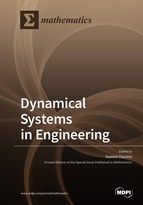Dynamical Systems in Engineering
A special issue of Mathematics (ISSN 2227-7390). This special issue belongs to the section "Dynamical Systems".
Deadline for manuscript submissions: closed (31 July 2021) | Viewed by 24341
Special Issue Editor
Interests: differential/difference equations; dynamical systems; modeling and stability analysis of electric power systems; mathematics of networks; fractional calculus; mathematical modeling (power systems, materials science, energy, macroeconomics, social media, etc.); optimization for the analysis of large-scale data sets; fluid mechanics; discrete calculus; Bayes control; e-learning
Special Issues, Collections and Topics in MDPI journals
Special Issue Information
Dear Colleagues,
This Special Issue aims to collect the latest results related to applications of dynamical systems in the mathematical modelling of engineering problems, such as those concerning power system dynamics, material science, energy systems, gas dynamical networks and many more.
This Special Issue will accept high-quality papers which have original research results, and its purpose is to bring together mathematicians with engineers and physicists, as well as other scientists.
Topics to be covered include, but are not limited to:
- Dynamical systems;
- Differential equations;
- Partial differential equations;
- Dynamical networks;
- Fractional calculus;
- Power systems dynamics;
- Mathematical modelling;
- Gas networks;
- Circuits and signals;
- Materials science;
- Energy systems.
Prof. Dr. Ioannis Dassios
Guest Editor
Manuscript Submission Information
Manuscripts should be submitted online at www.mdpi.com by registering and logging in to this website. Once you are registered, click here to go to the submission form. Manuscripts can be submitted until the deadline. All submissions that pass pre-check are peer-reviewed. Accepted papers will be published continuously in the journal (as soon as accepted) and will be listed together on the special issue website. Research articles, review articles as well as short communications are invited. For planned papers, a title and short abstract (about 100 words) can be sent to the Editorial Office for announcement on this website.
Submitted manuscripts should not have been published previously, nor be under consideration for publication elsewhere (except conference proceedings papers). All manuscripts are thoroughly refereed through a single-blind peer-review process. A guide for authors and other relevant information for submission of manuscripts is available on the Instructions for Authors page. Mathematics is an international peer-reviewed open access semimonthly journal published by MDPI.
Please visit the Instructions for Authors page before submitting a manuscript. The Article Processing Charge (APC) for publication in this open access journal is 2600 CHF (Swiss Francs). Submitted papers should be well formatted and use good English. Authors may use MDPI's English editing service prior to publication or during author revisions.






